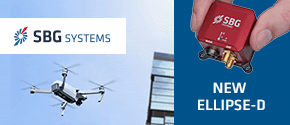| Perspective | |
Geospatial industry must focus on making big data more useful
The relevance of geospatial information and technology to continue to build upon its current momentum and grow increasingly relevant to many and varied business processes |
 |
|
As we anticipate technology trends unfolding in 2019, the dominant theme for the geospatial industry is the need for precise data and the ability to make that data useful in more workflows and in varying markets around the world.
We predict geospatial technology in the upcoming year will be shaped by cloud computing, artificial intelligence, autonomous vehicles, sensor fusion, ubiquitous use of geospatial data, 3D modeling and other advancements. These innovations can fail if they don’t clearly benefit users, so product development needs to be aligned with the work of our customers.
In 2019, here are several technology trends we expect to propel the geospatial industry forward:
Making more date more useful
While the industry has made great strides when it comes to making mass data collection easier, the real value of data is not in collecting it, but in using it for better decision-making. The geospatial industry must now turn its focus to making big data more useful, and in more meaningful ways. We believe we will see technology providers focus on the advancement of processing tools and software solutions that will help users turn their data into decisions in 2019.
Over the coming months, we also expect to see the continued adoption of a single geospatial data hub that enables users to bring all disparate data to a single department, enabling fieldto- finish with more confidence. With the support of a “central hub,” geospatial professionals will also be better informed to select the best hardware tool for the job, regardless of whether they walk it, fly it or drive it to gather data.
The ultimate goal is to shift away from siloed collections of data toward more reliable and useful systems of record that can be referenced by multiple users across multiple disciplines. Cloudbased platforms and feature services will play a major role in eliminating unnecessary physical data transfer and enabling easier project collaboration and information exchange, all of which makes it easier to leverage big data to make better business decisions.
Harnessing the power of sensor fusion
Looking ahead, we expect sensor fusion technologies – which combine multiple different sensor types or technologies in ways that maximize their combined strengths while minimizing their combined weaknesses – to include more IMUs, GNSS and emerging technologies like Solid State Lidar and SLAM processing. These innovations will continue to make it possible to blend multiple disciplines of mass geospatial data capture into one seamless process.
Mobile mapping systems are one example. They combine the various strengths and weaknesses of different types of sensors — inertial (IMU), wheel speed, GNSS, cameras and LiDAR — and fuse these sensor outputs, achieving greater level of accuracy and detail enabling detailed engineering, operation and design.
Having different types of sensor data can be extremely powerful, but even more beneficial is fusing that data for analysis and decision making. Supported by the right software, sensor fusion is about getting the most out of various sensors and sensor combinations to solve business problems. We believe this type of technology integration will remain a priority in 2019 as more geospatial professionals take advantage of unique sensor combinations that provide enhanced geospatial context and understanding.
Increasing technology access with as-a-service business models
In recent years, enterprise organizations have increasingly adopted the subscription or pay-per-use service model rather than one-time technology purchases. The “As-a-Service” business models offers substantial benefits, including a more predictable cash flow and streamlined workflows, and we expect it to continue to gain in popularity in the coming year.
The As-a-Service approach also results in more people using their smartphones and mobile devices to receive satellite data for a precise position – a technology advancement that will multiply the capability of organizations to increase the adaption of professional grade measurement technology in the coming years.
Better understanding site conditions with visualization and AR/MR
The use of augmented reality (AR) and mixed reality (MR) tools will increase in the next several years, in part because geospatial data, such as point clouds, complex meshes and terrain models, is often difficult to explain and deliver to clients. AR, MR and other visualization tools make it easy to understand existing site conditions by overlaying models over the existing environment. For example, a user of augmented reality technology could view existing underground services and future landscapes overlaid on a worksite to avoid hitting a utility line during excavation work. Other benefits include collaboration, planning and asset management. Organizations that can offer this functionality to their customers will have an edge on the competition in 2019 and beyond.
Generating rich data via 3D modeling, bim
The mixed reality solutions mentioned above thrive on accurate and properly attributed 3D models. The design and construction industry is at a tipping point in which Building Information Modeling (BIM) can positively affect geospatial professionals’ work the more they embrace it. However, prospective BIM adopters need to realize the technology not only provides intelligent 3D modeling, but it also offers a centralized platform for sharing data to help partners communicate effectively, in real-time.
When surveyors take advantage of BIM holistically, they are both factoring in the traditional aspects of a building’s design and generating rich data spanning the range of properties of a structure’s components, construction and maintenance.
The increased adoption of BIM technology represents a paradigm shift in the design, build and operate process. At its core, BIM is meant to transform how project teams work together on a job, from start to finish, and we expect to see increased discussion, development and adoption of BIM technology in the coming months and years.
More widespread reliance on geospatial information
Geospatial data is no longer utilized just by surveyors and those trained in the collection and use of geospatial data. I expect the relevance of geospatial information and technology to continue to build upon its current momentum and grow increasingly relevant to many and varied business processes. As such, barriers that previously segmented functionalities will increasingly dissolve, with further integration driven by innovation. This integration will help reduce the gap between data capture, processing, analysis and delivery of an easy-to-understand, cohesive image of the real world, from surveyor to customer.












 (No Ratings Yet)
(No Ratings Yet)




Leave your response!